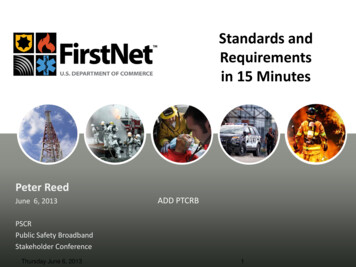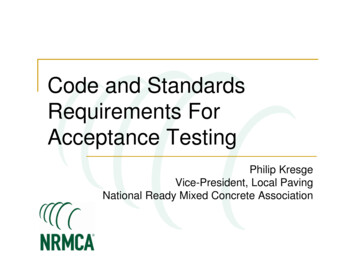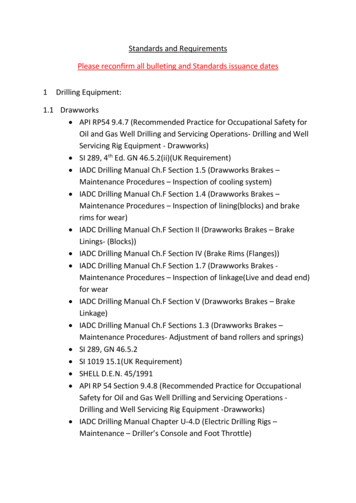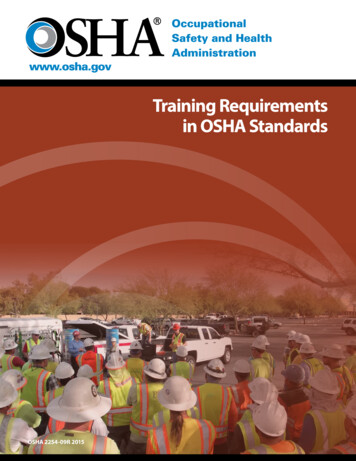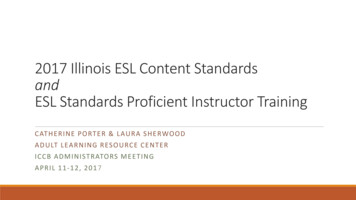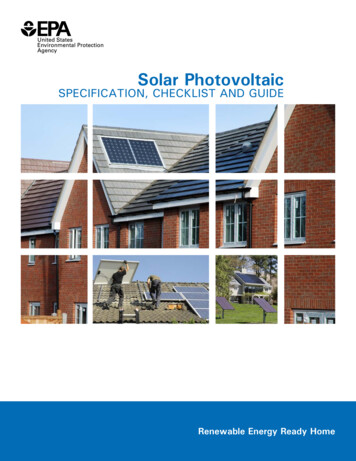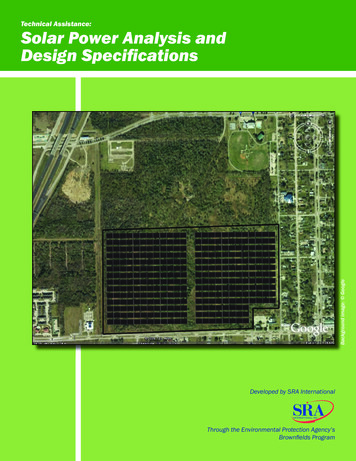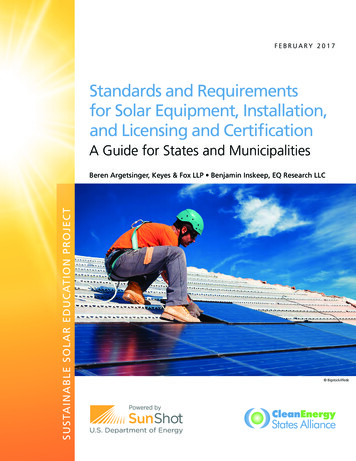
Transcription
february 2017Standards and Requirementsfor Solar Equipment, Installation,and Licensing and CertificationA Guide for States and MunicipalitiesSustainable Solar Education ProjectBeren Argetsinger, Keyes & Fox LLP Benjamin Inskeep, EQ Research LLC Bigstock/ilfede
Sustainable Solar Education ProjectAbout this Guide and the Sustainable Solar Education ProjectStandards and Requirements for Solar Equipment, Installation, and Licensing andCertification: A Guide for States and Municipalities is one of six program guides beingproduced by the Clean Energy States Alliance (CESA) as part of its Sustainable Solar Education Project. The project aims to provide information and educational resources tohelp states and municipalities ensure that distributed solar electricity remains consumerfriendly and its benefits are accessible to low- and moderate-income households. In addition to publishing guides, the Sustainable Solar Education Project will produce webinars,an online course, a monthly newsletter, and in-person training on topics related tostrengthening solar accessibility and affordability, improving consumer information, andimplementing consumer protection measures regarding solar photovoltaic (PV) systems.More information about the project, including a link to sign up to receive noticesabout the project’s activities, can be found at www.cesa.org/projects/sustainable-solar.About the U.S. Department of Energy SunShot InitiativeThe U.S. Department of Energy SunShot Initiative is a collaborative national effortthat aggressively drives innovation to make solar energy fully cost-competitive withtraditional energy sources before the end of the decade. Through SunShot, the EnergyDepartment supports efforts by private companies, universities, and national laboratoriesto drive down the cost of solar electricity to 0.06 per kilowatt-hour. Learn more atwww.energy.gov/sunshot.AcknowledgmentsThis work is based upon work supported by the U.S. Department of Energy SunShotInitiative, under Award Number No. DE-EE0007321. The authors would like to thank thefollowing individuals for their contribution to this guide: Matt Piantedosi of The CadmusGroup; Elizabeth Hutchison of the California Energy Commission; Michael Forrester atthe City of Cincinnati; Jeff Lyng and Tom Plant of the Center for the New Energy Economy;Isabelle Hazlewood, Edward Kranich, and Selya Price of the Connecticut Green Bank;Jeni Hall of Energy Trust of Oregon; Tim Lindl and Joseph Wiedman (formerly) of Keyes& Fox; Andrew Belden and Elizabeth Youngblood of the Massachusetts Clean EnergyCenter; Stacy Miller of the Minnesota Department of Commerce; Travis Lowder of theNational Renewable Energy Laboratory; Max Joel and Frank Mace of the New YorkState Energy Research & Development Authority; Shauna Beland of the Rhode IslandOffice of Energy Resources; Ryan Barnett and Danielle Bentz of SolarCity; and EvelynButler of the Solar Energy Industries Association all provided guidance and input inthe development of this guide. The following CESA staff also provided valuable reviewof the guide: Maria Blais Costello, Diana Chace, Warren Leon, and Nate Hausman.DisclaimerThis material is based upon work supported by the U.S. Department of Energy under AwardNumber DE-EE0007321. This report was prepared as an account of work sponsored by an agencyof the United States Government. Neither the United States Government nor any agency thereof,nor any of their employees, makes any warranty, express or implied, or assumes any legal liabilityor responsibility for the accuracy, completeness, or usefulness of any information, apparatus, product,or process disclosed, or represents that its use would not infringe privately owned rights. Referenceherein to any specific commercial product, process, or service by trade name, trademark, manufacturer, or otherwise does not necessarily constitute or imply its endorsement, recommendation,or favoring by the United States Government or any agency thereof. The views and opinionsof authors expressed herein do not necessarily state or reflect those of the United StatesGovernment or any agency thereof.2C l e a n E n e r g y S tat e s A l l i a n c e
ContentsSection 1Introduction . . . . . . . . . . . . . . . . . . . . . . . . . . . . . . . . . . . . . . . . . . . . . . . . . . . 4Section 2Installation . . . . . . . . . . . . . . . . . . . . . . . . . . . . . . . . . . . . . . . . . . . . . . . . . . . . 5Building CodesFire CodesElectrical CodesPlanning and Zoning for SolarRecommendations and ConsiderationsSection 3Licensing and Certification . . . . . . . . . . . . . . . . . . . . . . . . . . . . . . . . . . . . . . . 21General Electric LicensingLimited Electric LicensingThird-Party CertificationExamples of Programs that Include Certification for Solar ContractorsOther Issues: Installer Databases and Contractor ListsRecommendations and ConsiderationsSection 4Equipment Standards and Warranties . . . . . . . . . . . . . . . . . . . . . . . . . . . . . . 35Equipment StandardsManufacturer and Workmanship WarrantiesRecommendations and ConsiderationsSection 5Conclusion . . . . . . . . . . . . . . . . . . . . . . . . . . . . . . . . . . . . . . . . . . . . . . . . . . . . 42Section 6Additional Resources . . . . . . . . . . . . . . . . . . . . . . . . . . . . . . . . . . . . . . . . . . . . . . 43Endnotes . . . . . . . . . . . . . . . . . . . . . . . . . . . . . . . . . . . . . . . . . . . . . . . . . . . . . . 45S ta n d a r d s a n d R e q u i r e m e n t s f o r S o l a r E q u i p m e n t, I n s ta l l at i o n , a n d L i c e n s i n g a n d C e r t i f i cat i o n3
Sustainable Solar Education ProjectSection 1IntroductionThis guide is intended as a starting point for program managers in states or municipalitieswho are developing or revising standards and requirements for installation, licensingand certification, equipment, and warranties for solar photovoltaic (PV) equipmentand systems. It discusses a selection of programs and rules in these areas to highlightvarious means by which states and municipalities have addressed these topics and how theyimpact the implementation of solar policy goals. The guide develops recommendationsand considerations for each topic area based upon review of numerous state and local solarprograms and in consultation with program managers, solar installers, consultants, andnon-governmental organizations. Bigstock/Goodluz4C l e a n E n e r g y S tat e s A l l i a n c e
Section 2InstallationThe installation of rooftop solar PV systems raises issues related to building, fire, andelectrical codes. Because rooftop solar is a relatively new technology and often addedto a building after it is constructed, some code provisions may need to be modified toensure that solar PV systems can be accommodated while achieving the goals of thecodes. Some primary code issues that impact rooftop PV installations include: Restrictive or ambiguous language written into the codes; Lag time between the release of updated model codes and new PV industry best practicesand the widespread adoption of the codes and best practices; Variation across jurisdictions in which code editions and amendments are adopted; and Inconsistent, inefficient, or improper enforcement of codes.Building, fire, and electrical codes are adopted at the state level in some states and at the locallevel in others. State-level code adoption can provide a level of consistency and uniformityto the industry that reduces costs, in comparison to a state where there are inconsistenciesbetween various municipalities. On the other hand, codes adopted at the state level may restricta local government’s ability to update codes to reflect new information or best practices orto make modifications to suit its unique needs and conditions.1 In “Dillon’s Rule” states, thestate retains all powers except those that are explicitly delegated to the local jurisdictions. In“Home Rule” states, the local jurisdictions are delegated all powers except those explicitlyretained by the state.2Authorities having jurisdiction (AHJs) may have different, and in some cases overlapping,powers and responsibilities over the solar installation process. For example, AHJs responsiblefor implementing building and fire codes may include state fire marshals, county buildingand health departments, and local development authorities and fire departments. In Dillon’sRule states that have adopted statewide codes, local governments are typically restricted toapplying the state code.3 In Home Rule states, code adoption may be controlled at eitherthe state or the local level.Code enforcement is essential to ensuring that rules are followed and properly implemented.Even well designed and unambiguous codes can fail to achieve their purpose if buildingS ta n d a r d s a n d R e q u i r e m e n t s f o r S o l a r E q u i p m e n t, I n s ta l l at i o n , a n d L i c e n s i n g a n d C e r t i f i cat i o n5
Sustainable Solar Education Projectinspectors, permitting staff, fire marshals, and other personnel lack the training and othersupport to correctly and consistently apply code standards. In many states, regardless ofwhether code adoption is a state-level function (i.e., a Dillon’s Rule state) or a local jurisdiction-level function (i.e., a Home Rule state), code enforcement is performed by localjurisdictions.Although local authority leverages local expertise and provides local governments withflexibility, variation across jurisdictions can add complexity and additional permitting andother compliance costs for solar installers, as well as inconsistencies in PV inspections. Theseissues are of particular concern to solar installers who work in multiple jurisdictions, as wellas state-level program administrators tasked with overseeing statewide solar implementationprograms. State-level policymakers and solar program administrators can help address theseissues by providing local jurisdictions guidance and other support resources to foster greaterconsistency in code adoption and enforcement as it pertains to PV installation.Several model codes have been developed to promote minimum standards and uniformityacross AHJs. Most notably, the International Code Council, a membership association thatsupports building safety and fire prevention, updates its model codes every three years.Model codes from the International Code Council, including the International BuildingCode, International Residential Code, and International Fire Code, have been widelyadopted, with state and local modifications, across the U.S.4A National Renewable Energy Laboratory (NREL) report, Clean Energy in City Codes:A Baseline Analysis of Municipal Codification across the United States, released in December2016, found that in a sample of 1,266 U.S. municipalities, 45 percent referenced solar intheir municipal codes. In four selected states—California, Florida, Maryland, and Minnesota—30 percent of all solar references in municipal codes relate to development and designstandards. The report notes that “often, these references exclude solar installations frombuilding height requirements, require screening of solar equipment from public view, requiresystems to conform to the Uniform Solar Energy Code or other fire and safety codes, addresssetback requirements, or require other aesthetic, landscape, or building orientation changesamong a myriad of other design-related stipulations.”Building CodesBuilding codes set minimum standards for structures and buildings to protect public health,safety, and welfare. Building code requirements related to installation, materials, wind resistance, and fire classification can help ensure the safe installation and operation of PV systems.AHJs typically require a PV system to pass a permitting and inspection process prior to commissioning. Inconsistency across AHJs in building code adoption and amendments can createchallenges for solar installers and contractors. The permitting and inspection process canbe lengthy, costly, and uncertain in some jurisdictions.Model building codes assist AHJs in creating uniformity in their building codes. Often,AHJs will adopt amendments or modifications to model building codes to meet local preferences or circumstances. Building codes in most states and local jurisdictions in the U.S. arebased on various editions of the International Code Council’s model building and residentialcodes. The International Residential Code, which applies to detached one- and two-family6C l e a n E n e r g y S tat e s A l l i a n c e
dwellings and townhousesthree stories or less, and theInternational Building Code,which applies to buildings andstructures not covered by theInternational Residential Code,have been widely adopted.Still, there is significant variation across jurisdictions in howquickly updated editions ofthe model codes are adopted.The current versions of theInternational Residential Codeand the International BuildingCode require rack-mountedrooftop PV systems to beinstalled according to themanufac-turer’s instructions,the National Electrical Code, and Underwriters Laboratories product safety standards [suchas UL 1703 (PV modules) and UL 1741 (Inverters)], which are design requirements andtesting specifications for PV-related equipment safety (see Equipment Standards below).5 Bigstock/keithpixThe International Residential Code also requires that: The roof be structurally capable of supporting the load of the modules and racking; The modules and racking be non-combustible; and Roof or wall penetrations (such as to attach the racking to the roof ) be flashed andsealed to prevent water, rodents, or insects from entry.The International Building Code also: Requires that rooftop solar systems have the same fire classification as the roofassembly;6 and Establishes criteria for calculating the minimum design loads for rooftop solar PVsystems, including guidance on wind load engineering calculations.7These model c
01.10.2010 · systems to conform to the Uniform Solar Energy Code or other fire and safety codes, address setback requirements, or require other aesthetic, landscape, or building orientation changes among a myriad of other design-related stipulations.” buildinG codes Building codes set minimum standards for structures and buildings to protect public health, safety, and welfare. Building code


